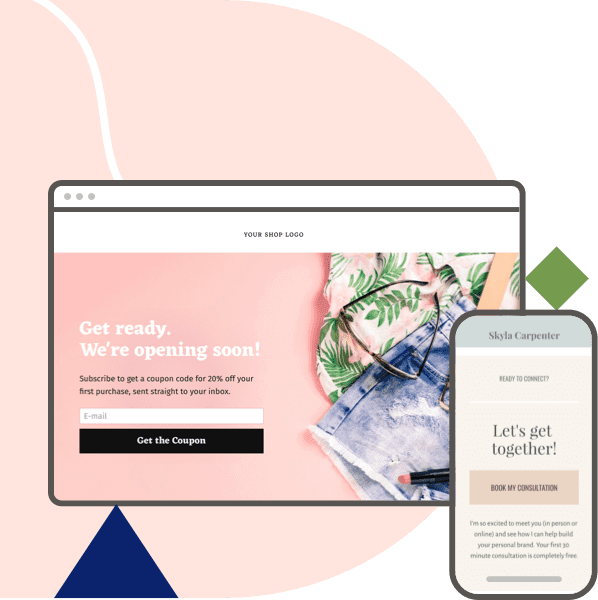Whether you need landing pages to drive more email signups, promote an upcoming event, or get more leads into your funnel, Leadpages and Unbounce are two worthy options to consider.
But, how do Leadpages and Unbounce stack up against each other?
We’ve put these two conversion-focused landing page builders head to head to see which one is right for your needs and budget. We’ll take into account seven major criteria that are most important to small businesses when evaluating conversion marketing platforms.
Right out of the gate, both Leadpages and Unbounce are solid platforms. They each offer the ability to build landing pages that are designed to convert traffic into leads and sales.
They’ve also both stood the test of time as leaders in this space. Unbounce launched their builder in 2010, Leadpages in early 2013.
But while they’re both excellent at what they do, there are key differences that need to be considered. So, let’s take a closer look at these two platforms to see what they have to offer.
Note: Comparisons presented on this page were last updated in January 2022, and feature Leadpages vs. Classic Unbounce.
1 - Ease of Use
Leadpages
Literally anyone can use Leadpages to build and publish a landing page in one day or less. No design experience needed. No coding chops required. If you can use a mouse and keyboard you can use Leadpages.
Leadpages’ Drag-&-Drop Builder makes it easy to move content around, add page elements, and make edits quickly. So instead of taking days to build a landing page, you can do it in a few hours.
And because it’s built on a system of sections, rows, and columns, content snaps into place and looks professionally made. The tool is very intuitive, straightforward, and ideal for non-web designers.
All of Leadpages’ templates are built for conversion. But the Leadmeter takes it one step further by predicting how well your page will convert as you build it. It provides you with guidelines and step-by-step recommendations for your images, copy, and layout that are based on best practices—so you know what to tweak as you go. This allows you to create a high-converting landing page, regardless of your conversion optimization experience.

Want a little more customization? While beginners don’t need to touch a line of code, experienced coders can customize designs using the HTML widget and CSS customizations if they wish. You can also upload custom fonts to get the exact vibe you want.
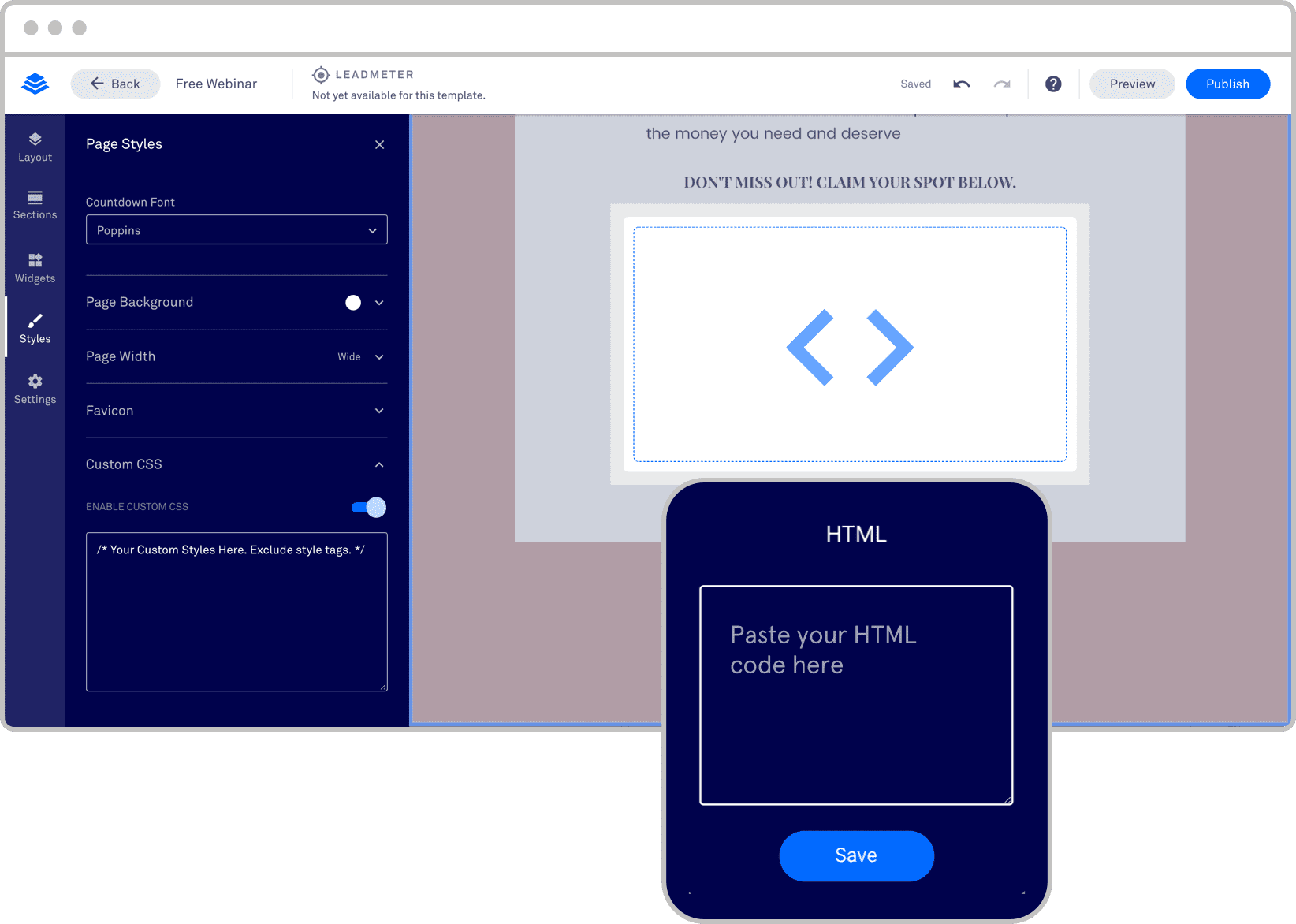
Unbounce
Unbounce is a powerful and flexible landing page builder for desktop and mobile devices. While it offers a drag and drop interface for newer users, it also allows for deeper customization thanks to its JavaScript and CSS capabilities.
The drag and drop editor is grid-free, which can provide users with more flexibility in building pages and placing elements. However, more skill and care is required when dropping elements into place.
It’s also worth noting that Unbounce doesn’t offer a comparable feature to Leadpages’ Leadmeter. So if you don’t have any experience with conversion rate optimization you may need to do some additional research before building your first page.
Verdict:
Both platforms do different things well, so it really depends on your unique needs.
Leadpages is more suited for those with less web design experience. The user-friendly builder and Leadmeter make it simple to build an effective landing page in just a few hours, even if you’re a complete beginner.
Unbounce’s builder, on the other hand, provides more flexibility and customization. If you’re a web design pro this might be more to your liking.
2 - Functionality
Leadpages
Currently, Leadpages integrates with more than 90 popular online marketing tools—that’s in addition to over 2,000 additional integrations available via Zapier. This ensures that no matter what tools and apps you use for your business, they’ll work seamlessly with your Leadpages landing page.

Some of the more popular Leadpages integrations include Stripe for payments, Calendly for consultation scheduling, MailChimp and AWeber for email marketing, and OpenTable for restaurant reservations.
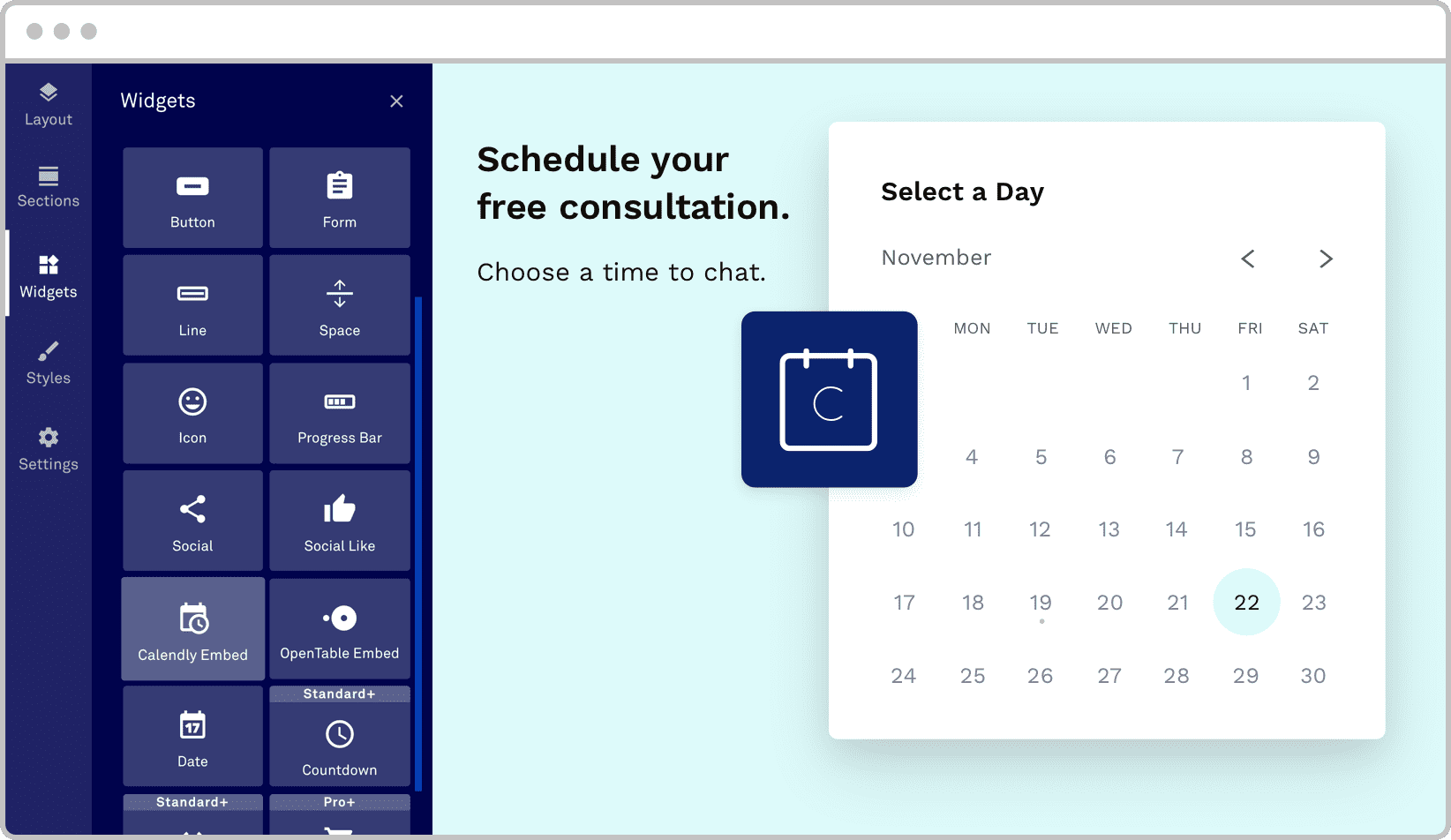
Unbounce
Unbounce has built up a hefty integration portfolio. With 116 integrations, including all major ESPs, CRMs, webinar platforms, and social networks, this impressive line-up covers virtually all of the most popular business and marketing tools available.
Like Leadpages, you can connect additional tools with Zapier, providing even more options when it comes to integrations.
Verdict:
Both platforms offer a variety of powerful integrations. Ultimately, Unbounce offers more native integrations, but since Zapier can be used with both this is essentially a tie.
3 - Look & feel
Leadpages
One of the big advantages of using Leadpages is the vast template library. The platform offers over 220 professionally designed landing page templates (plus over 50 website templates) to choose from.
All the templates have been created with conversions in mind, so you know whichever one you choose will deliver the results you’re looking for. Leadpages also makes finding the right template easy, with the ability to sort them by industry, style, and color. Or if you’re solely focused on getting leads you can even sort them by conversion rate to find the templates that convert the best.
Every template is mobile responsive, so pages look the way they’re supposed to on every device. Plus, you can add or hide sections depending on which device they’re being viewed on.
Unbounce
With more than 151 landing page templates, Unbounce gives you plenty of options. Their library is categorized into landing page templates, sticky bar templates, pop-up templates, or AMP-specific designs.
While you’re not able to sort templates by conversion rate, you can filter them by industry, campaign type, name, recent, and popular. This makes it easy to find something that aligns with your brand, campaign, or promotion.
Page preview is available on desktop and mobile. Some elements may need to be edited for mobile directly, unlike Leadpages’ automatic mobile optimization. However, Unbounce’s mobile editing is very intuitive.
Verdict:
If we’re just looking at the total number of templates, Leadpages wins here. They also offer the ability to sort by conversion rate, which makes finding the right template a lot easier.
However, there’s more to consider than just the total number of templates. Design is a matter of taste, and it’s quite possible that you prefer the look and feel of one platform’s designs over the other.
So, we recommend you review both platforms’ template galleries to see which one you prefer.
4 - Conversion tools
Leadpages
Leadpages is, through-and-through, a conversion platform. All of its features and products have one single end goal: turning your traffic into leads and sales. This is achieved by offering a wide range of effective conversion tools:
- Leadmeter: predicts how well your page will perform and tells you what to tweak before you publish it.
- Alert bars: top-of-page text bars you can use to promote lead magnets, special offers, events, and more.
- Pop-ups: capture the attention of potential customers as they arrive on your site, or as they’re about to leave.
Leadpages also offers conversion tracking, unlimited A/B testing, and easy payment integration through Stripe. And all of that is in addition to hundreds of templates that were designed to maximize conversions.
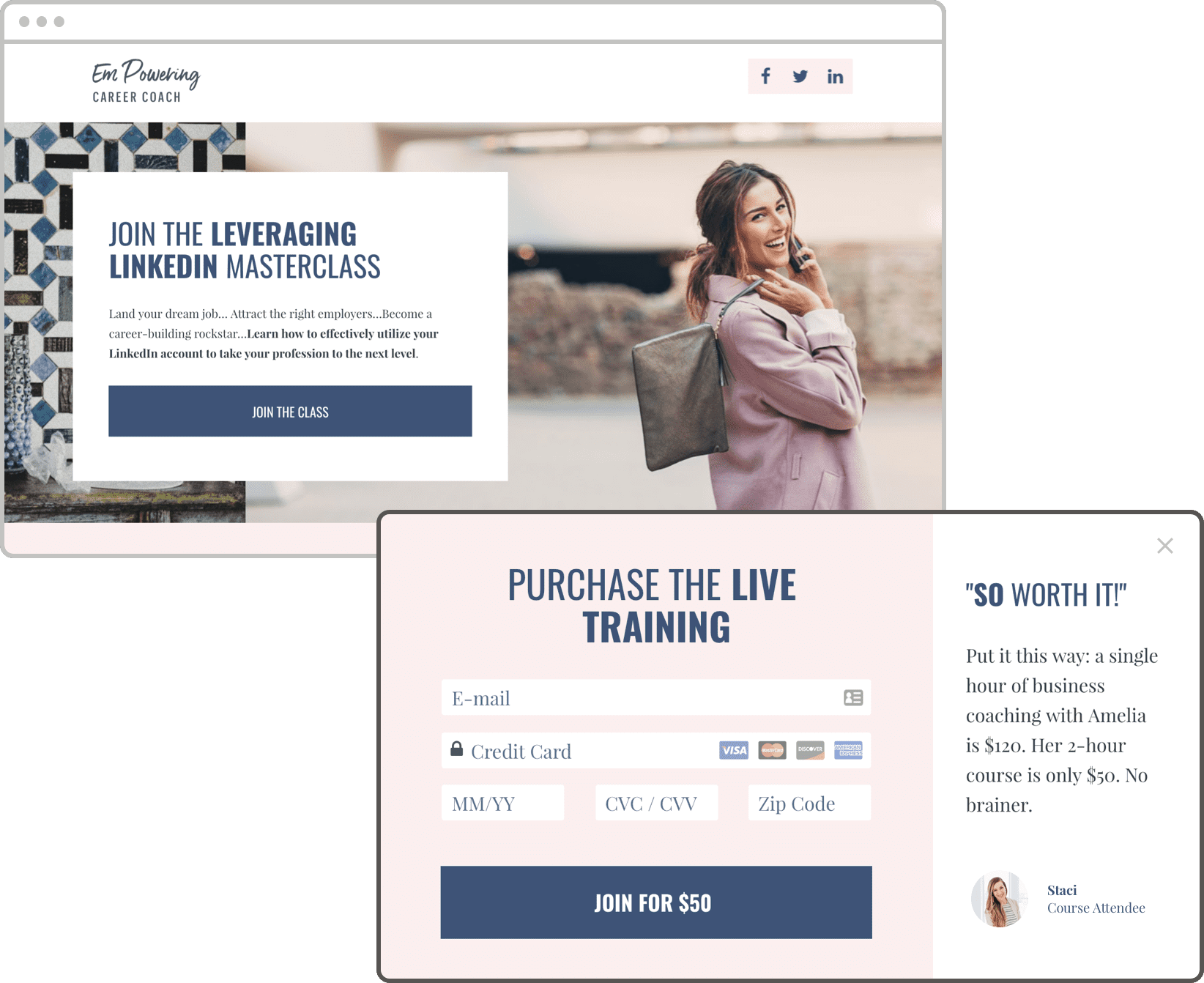
Plus, any customer of Leadpages can use the lead magnet delivery feature to send an initial welcome email with a lead magnet to new leads and customers.
Finally, Leadpages’ Lead Library allows you to store and find lead information quickly and easily, right inside the platform—no need to export them (unless you want to).
Unbounce
Unbounce—as its name implies—is also all about reducing bounces and turning traffic into leads. Their templates are designed to convert, so right away you’re set up for success. Unbounce offers sticky bars and pop-ups that make it easy to promote offers or content downloads. And, A/B testing is available on all plan types.
Once you have your leads, Unbounce makes it easy to send that information to CRMs and marketing automation tools, such as Salesforce, Zoho, HubSpot, Mailchimp, and more.
Verdict:
As far as conversion tools go, lead magnet delivery, A/B split testing, and downloadable .CSV files of opt-in data are available on both services. So they’re pretty much on par with their lead capture capabilities, although Unbounce does allow you more flexibility to customize pop-ups with their free form editor.
The one area that gives Leadpages a slight edge is the Leadmeter. By providing real-time tips as you build, this Leadpages-specific technology can drastically improve the likelihood of your landing page converting.
5 - Publishing options
Leadpages
Leadpages offers many different publishing options. Every account comes with free hosting on a custom Leadpages subdomain (https://your-domain.lpages.co). You can also publish on a third-party domain that you already own, or purchase a Leadpages annual subscription and receive a free domain for one year (powered by Hover).
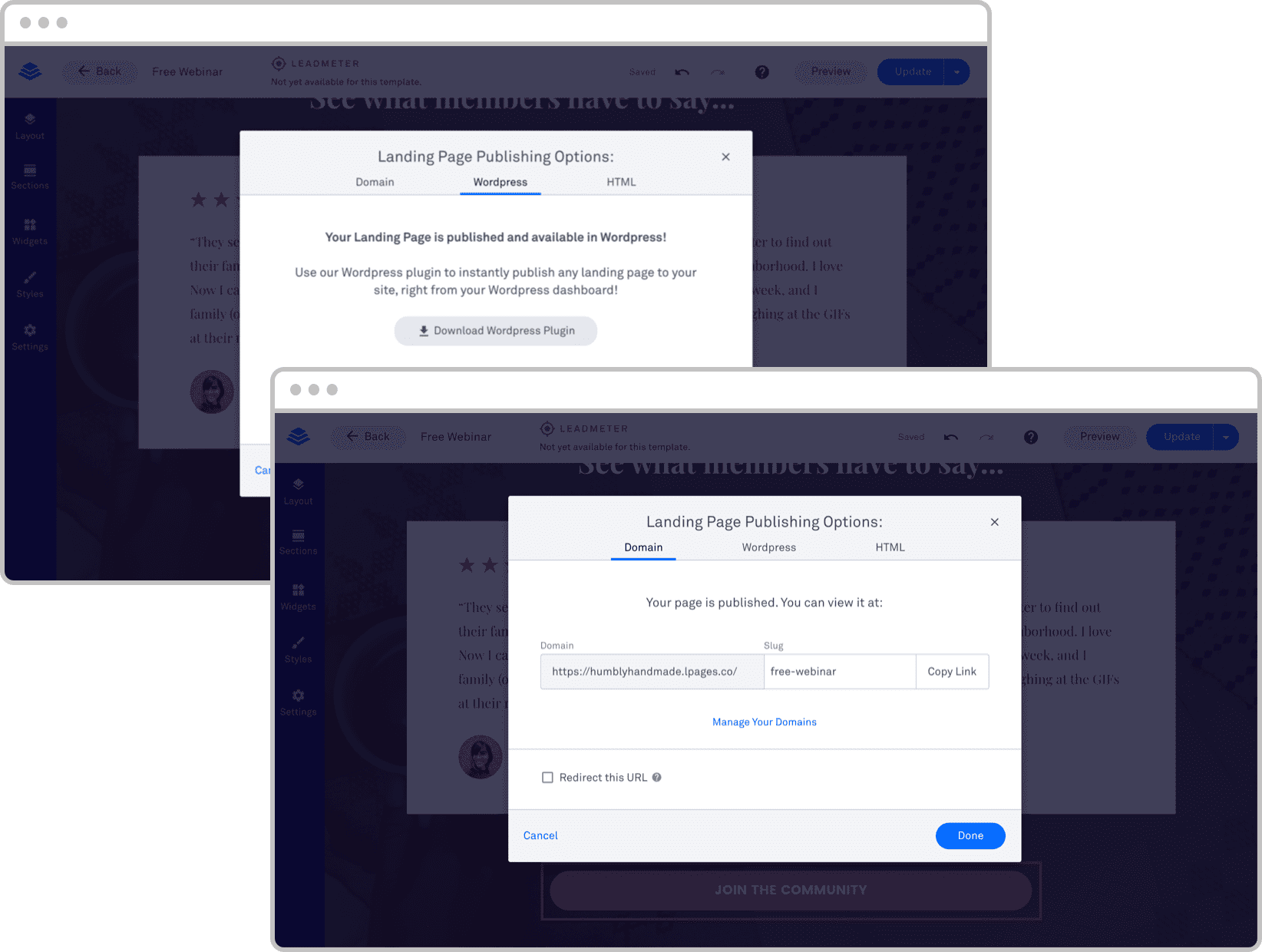
Plus, every Leadpages account includes a plugin you can use to publish your landing pages, pop-ups, and alert bars on your WordPress site. You can even publish your page as a dynamic HTML page, which automatically updates when you make changes in Leadpages.
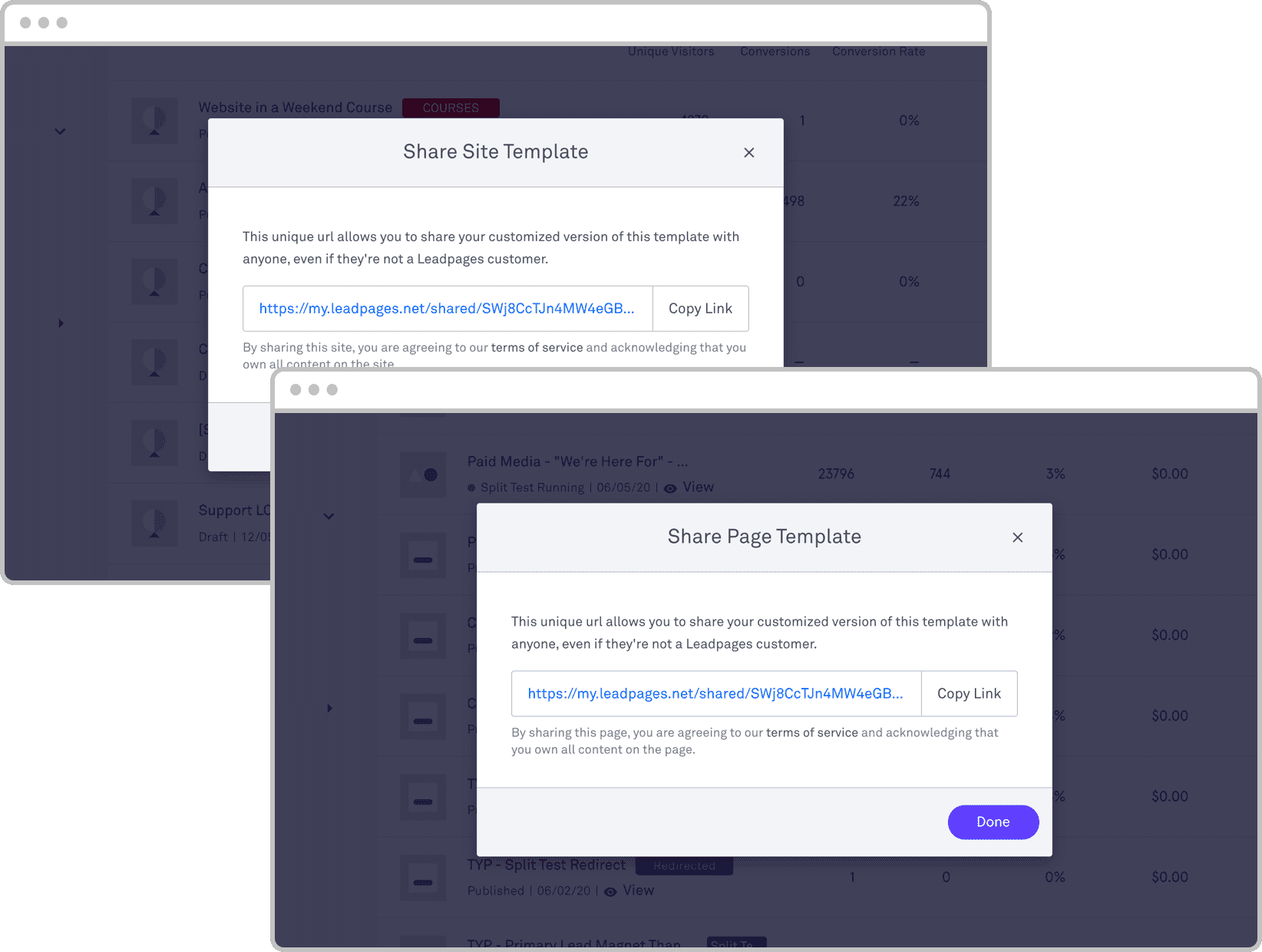
Want to show your page to other team members? Leadpages makes it easy to share a landing page or website template with your team or clients (at no additional cost).
Unbounce
Similar to Leadpages, with Unbounce you can publish your page to a free subdomain, custom domain, or a WordPress site. One unique feature is scheduled publishing, which allows you to schedule a page to go live at a specific date and time.
Unbounce also makes sharing your page easy with multi-user permissions such as admin, author, or viewer. However, the lowest plan tier limits the number of users to two.
Verdict:
Side-by-side, the offerings are virtually identical, so we’ll call this one a tie. Unbounce has a bit of an advantage with scheduled publishing and multi-user permissions. But the fact that you can get a free custom domain with Leadpages is a plus. It’s also important to note that all Leadpages customers can build an entire website within any plan, not just landing pages.
6 - Traffic & advertising
Leadpages
Leadpages offers an easy-to-understand analytics dashboard with real-time data that includes visitors, conversions, and conversion rate. So there are a lot of ways to track how well your page is performing.
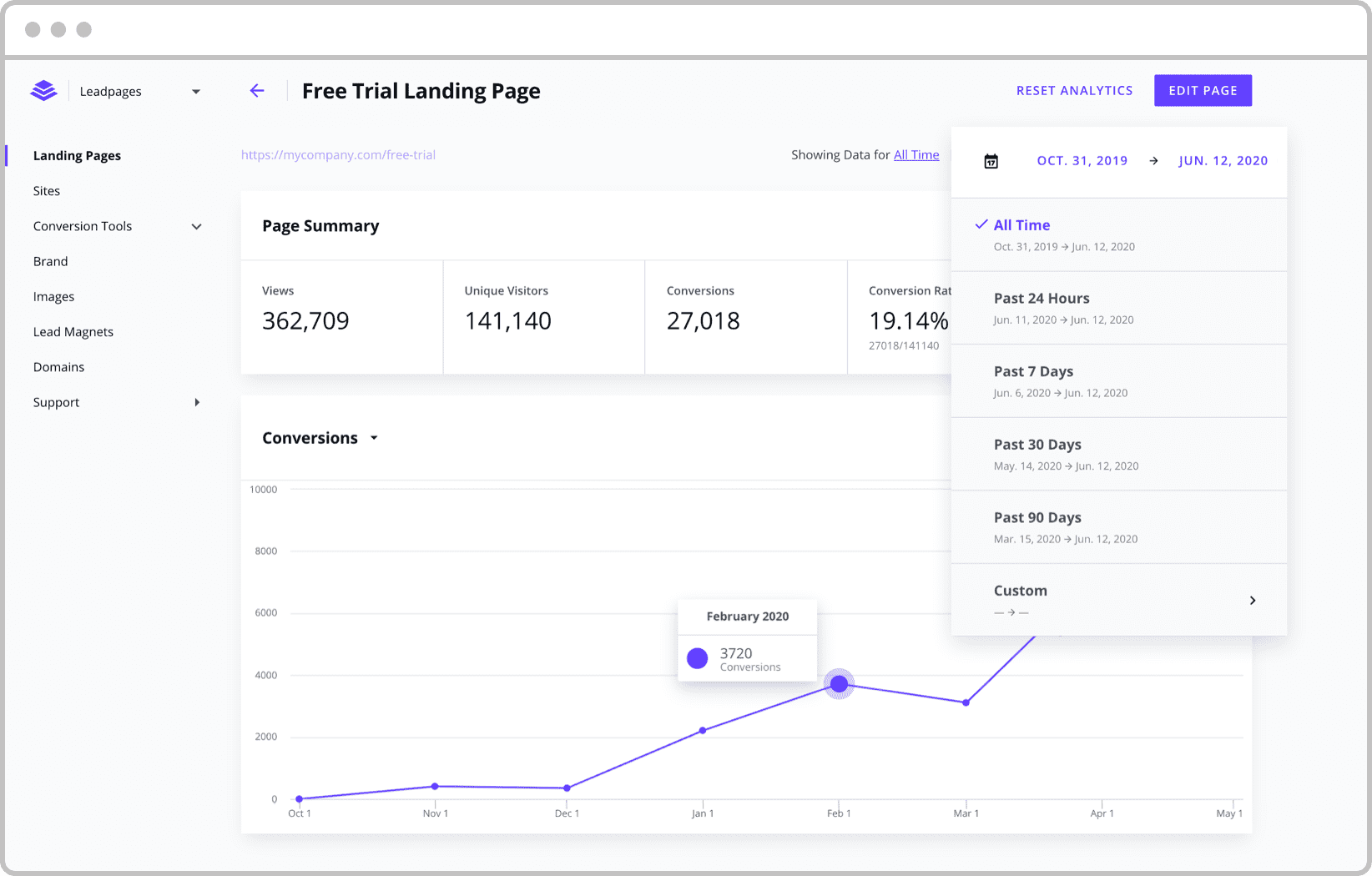
Leadpages also gives you tools to improve your search engine optimization. Use the SEO settings and previews to edit your meta title, keywords, and description to ensure your page is optimized for all the most important search terms.
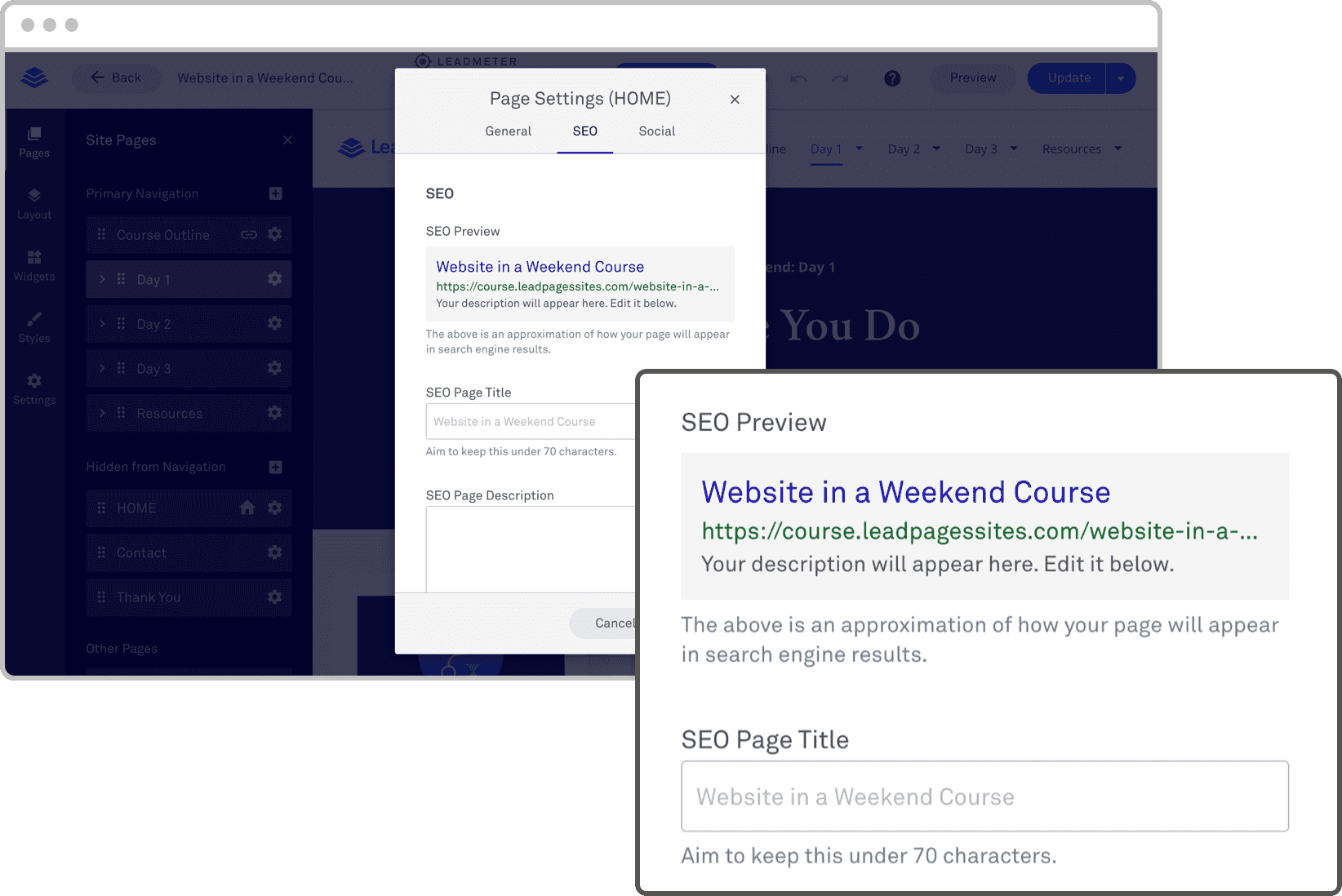
Another big plus for Leadpages is their industry-leading page load speed (faster by 2.4 seconds on average). Not only does this help with SEO, but it lowers your bounce rate and increases conversions.

Unbounce
Unbounce has a feature called AMP landing pages, which tells Google your page is ultra-fast. So fast, in fact, that it’s designated with a gray lightning-bolt logo beside your page in Google on mobile devices.
Like Leadpages, Unbounce allows you to easily edit your metadata. Simply click “Page Properties” in the builder to customize your meta title, keywords, and description.
Finally, Unbounce offers real-time performance analytics that includes more in-depth data than the basic information provided by Google Analytics.
Verdict:
Both platforms have merits in this department. Real-time analytics and a dashboard that clearly shows traffic and conversion rates are available for both services.
However, Unbounce’s AMP templates may help you stand out as they ensure top load speeds on mobile. Keep in mind though, that AMP is only available on their high end plans which can get quite pricey.
So, if your budget is big and AMP landing pages matter, Unbounce is a good choice. But for anyone that’s looking to lower their expenses, Leadpages’ page load speeds are excellent.
7 - Value
Leadpages
Value is about more than just who has the lowest price. It’s about what you get for that price. So, let’s break it down.
Leadpages has different pricing tiers to suit every budget. You can purchase a Standard, Pro, or Advanced plan on either a monthly or yearly basis. One way Leadpages provides a lot of value is that you get unlimited traffic, leads, and landing page publishing across all plans.
You’ll also get a website builder, something Unbounce doesn’t offer.
Here’s a breakdown of Leadpages’ plans:
- The Standard plan starts at $37/month (when paid annually) and offers everything mentioned above plus a website, free hosting, and all basic features.
- The Pro plan costs $74/month (when paid annually) and offers everything mentioned above plus three websites, unlimited A/B testing, and online sales and payments.
- Enterprise customers looking for even more features can contact Leadpages about the Advanced plan. This includes unlimited websites, advanced integrations, five sub-accounts, and top-tier customer support.
- Customers save 25% on average when they switch to an annual plan.
Unbounce
Unbounce offers a similar pricing model with several tiers which you can subscribe to on a monthly or annual basis.
- Launch plans start at $90/month with a limit of 500 conversions, 20,000 unique visitors, and unlimited landing pages/pop-ups/sticky bars.
- Optimize plans start at $135/month with a limit of 1000 conversions, 30,000 unique visitors, unlimited landing pages/pop-ups/sticky bars, and A/B testing.
- Accelerate plans start at $225/month with a limit of 2000 conversions, 40,000 unique visitors, unlimited landing pages/pop-ups/sticky bars, A/B testing, and Google AMP pages.
- Customers save 10% when they switch to an annual plan.
Each platform offers more features than are listed here. We’ve simply highlighted the most important ones for the sake of comparison. But we encourage you to visit each platform’s feature comparison page for the most up-to-date and accurate information.
Verdict:
When looking strictly at prices, Leadpages is the most affordable option. It also offers unlimited traffic across all plans, something Unbounce doesn’t do. When you add this to unique features like the Leadmeter and a website builder, Leadpages is a great choice.
That being said, Unbounce does have a few options that Leadpages doesn’t. This includes multi-user permissions and AMP landing pages. If you’re a medium to large business, Unbounce may provide the premium features you’re looking for. Its Smart Builder (currently in Beta) may also be something to consider if it’s a fit for your business needs.
The final verdict
So, is the final winner Leadpages or Unbounce? The answer depends on what you’re looking for.
Thinking about giving Leadpages a try? Sign up for a 14-day free trial to see if Leadpages is the right fit for your business.
